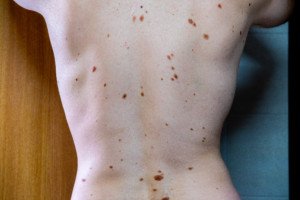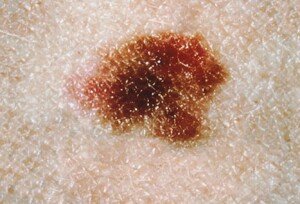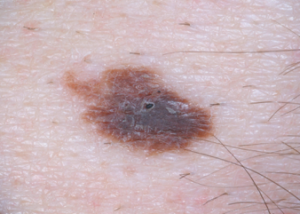
There is a rule of thumb for determining if you have too many moles – which of course, should be inspected monthly for any suspicious signs of melanoma, which is highly curable when caught early.
How to Tell if You Have too Many Moles
“My rule for having ‘too many moles’ is when the patient cannot remember all the moles that they have, and they need to rely on photos of the body parts to check the moles for changes,” explains Dr. Tess Mauricio, MD, FAAD, a leading board certified dermatologist from Stanford University Medical School and CEO of MBeautyClinic.com.
Many Normal Looking Moles
The protocol for melanoma-surveillance for a person with a bunch of normal and similar moles is not as strict as is the protocol for someone with the same number of naturally funny looking moles (dysplastic nevi).
A nevus (“knee-vus”) is a mole. “Nevi” (rhymes with “Levi”) is the plural.
A person may have many dysplastic nevi, also known as atypical moles. Many of these will net a diagnosis of atypical mole syndrome.
If you use a gym’s locker room a lot, you’ve certainly seen people with this condition.
The pencil eraser sized (and larger) moles are splattered all over their back, and instead of being mostly circular or oval, they look erratic.

Dysplastic mole. Cancer.gov
Dr. Mauricio explains, “Those with a family history of atypical mole syndrome or dysplastic nevus syndrome have to be even more careful,” when it comes to monthly self-exams.
“My threshold to biopsy moles in these individuals is very low. Better to err on the side of giving patients scars from the biopsy than to miss a melanoma.”
• Get to know your moles, up close and personal.
• If you have illustrative talent, draw the ones you can easily inspect – scaling them up many sizes and replicating their shape and relative darkness and lightness variations.
• Use reading glasses if your up-close vision is blurry.
• Take pictures.
• There are apps for mole surveillance, but these are NOT diagnostic tools for melanoma. They are only alerts for detected changes over time.
Professional Mole Mapping
Home mole mapping if you have way too many moles to keep track of is laborious, tedious and anxiety-provoking.
Let a dermatologist, nurse and computer do all the work for you: serial digital dermoscopy!
Your insurance may cover this if your dermatologist diagnoses you with dysplastic nevi.
Serial digital dermoscopy is state-of-the-art technology that compares recent images of your moles to past images and identifies changes.
The technology also assigns a rating for each mole: ranging from completely normal to suspicious enough to recommend a biopsy.
Here’s more on serial digital dermoscopy.
 Dr. Mauricio is an internationally recognized cosmetic surgeon and the youngest woman to hold the position of President of The San Diego Society for Dermatologic Surgery.
Dr. Mauricio is an internationally recognized cosmetic surgeon and the youngest woman to hold the position of President of The San Diego Society for Dermatologic Surgery.
 Lorra Garrick has been covering medical, fitness and cybersecurity topics for many years, having written thousands of articles for print magazines and websites, including as a ghostwriter. She’s also a former ACE-certified personal trainer.
Lorra Garrick has been covering medical, fitness and cybersecurity topics for many years, having written thousands of articles for print magazines and websites, including as a ghostwriter. She’s also a former ACE-certified personal trainer.
.









































